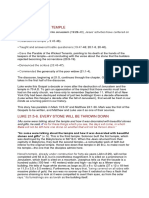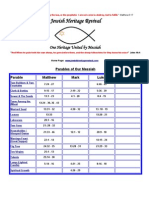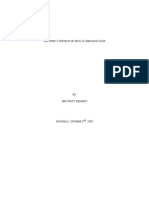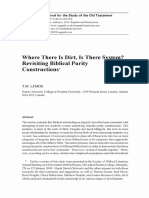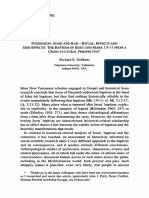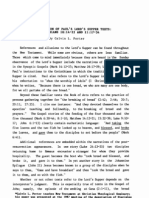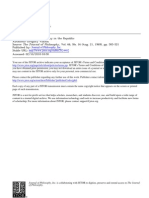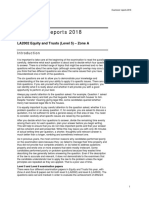Exegesis of MK 10.29-31
Exegesis of MK 10.29-31
Uploaded by
31songofjoyCopyright:
Available Formats
Exegesis of MK 10.29-31
Exegesis of MK 10.29-31
Uploaded by
31songofjoyOriginal Title
Copyright
Available Formats
Share this document
Did you find this document useful?
Is this content inappropriate?
Copyright:
Available Formats
Exegesis of MK 10.29-31
Exegesis of MK 10.29-31
Uploaded by
31songofjoyCopyright:
Available Formats
141
LEAVING AND RECEIVING: A SOCIAL-SCIENTIFIC EXEGESIS OF MARK 10:29-31
DAVID M.MAY Central Missouri State University, Warrensburg MO 64093-5060
INTRODUCTION If one can observe that for the Gospel of Luke, ' 'Jesus is either going to a meal, at a meal, or coming from a meal, " l then for the Gospel of Mark one may say: Jesus is either going to a house, at a house, or talking about a house. The Markan use of house illustrates that the main institution for realizing the traditional Jewish value of pleasing God is the fictive kinship group symbolized by the house rather than the fictive kinship group symbolized by the synagogue or the natural kinship network symbolized by the family. While it is beyond the scope of this paper to explore all the house references in Mark, one may focus upon the text-segment 10:29-31 which illustrates both the reorientation of kinship into a new fictive kinship group and the reorientation of politics (power) which is associated with a new land scheme. Nowhere in the Gospel of Mark is the discussion of houses2 and lands highlighted more than in Jesus' statement to his disciples at 10:29-31. This particular pronouncement by the Markan Jesus bears a focused exegesis for two reasons. First, it is strategically located in the Markan narrative. This saying is delivered at what could be called an in-between time or a transitional period for the Markan Jesus. In 10:10-16 Jesus is portrayed as settled in the context of the house giving a reorientation of norms. This reorientation is related to the specific behavior that is expected from the members of the new family as they receive the Kingdom of God. In 10:17-28 Jesus is preparing for a journey which is in full progress by v. 32. Therefore, the saying at 10:29-31 is delivered by Jesus as he is sandwiched between his settled-house teaching role and his peripatetic teaching role. The context of this saying is not like the previous text-segment (10:10-16) in which the reorientation of norms is in the environment of the domicile; nor is it like the forthcoming instruction-prediction discourse that Jesus delivers on the way to Jerusalem and within that city. As Mary Douglas points out, in-between times, ambiguous spaces, or objects partaking of two different natures are sometimes used "in poetry and mythology, to enrich meaning or to call attention to other levRobert J. Karris, Luke: Artist and Theologian (New York: Paulist Press, 1985) 47. included within the use of the term house would be all terms that are associated with kinship or the domicile.
1
142
PERSPECTIVES IN RELIGIOUS STUDIES
els of existence."3 The quality of in-betweenness of this text-segment is the specific element that would draw the attention of the original hearers. A second important aspect of this saying is its uniting of the two most significant social settings found within the first-century world: kinship and politics. Bruce Malina in numerous books and articles has clearly shown that kinship and politics were the most fundamental social structures of the firstcentury Mediterranean world and that all other social institutions, such as economics, education, and religion, were embedded in them.4 The role of kinship is easily recognizable in this text-segment with terms such as, house (oikia), brothers (adelphous), sisters (adelphas), fathers {patera), children (tekna), and mothers (meters). The use of the term land (agros) illustrates the second social setting, politics, which has its roots in power. As Malina points out, significant social status did not derive from the accumulation of money, goods, or things but from birth into noble groups which commanded large resources of land and labor.5 A thoughtful consideration of the two social structures, kinship and politics, assists in the process of a social-scientific exegesis. Furthermore, by utilizing a variety of models from the social sciences, such as the pivotal value of shame and honor, the patron-client relationship, and the concept of a limited good society, a more complete analysis of Mark 10:29-31 is possible. Such an analysis of the household language and agrarian imagery allows for an exegesis which has fewer ethnocentric and anachronistic tendencies. The end result is a clearer understanding of what Mark's original readers would have perceived according to their world-view.
BACKGROUND
Jesus' address in 10:29-31 is precipitated by a nameless man who approaches and questions Jesus about how he might inherit eternal life. Jesus, in turn, questions him, directs him to divest himself of his possessions, and then invites him to follow. On account of the perceived cost of following Jesus, the man is discouraged and fades out of the Markan narrative on a sorrowful note. Jesus then issues a new norm which defamiliarizes the cultural assumption regarding wealth and possessions and climaxes in a saying that speaks to the Markan community. The defamiliarization process occurs in an alternating and narrowing sequence: (1) Jesus' initial statement regarding riches, v. 23; (2) the non-vocalized amazement of the disciples, v. 24a; (3)
^Mary Douglas, Purity and Danger: An Analysis of the Concepts of Pollution and Taboo (London: Routledge & Kegan Paul, 1966) 40. 4 Bruce Malina, "'Religion' in the World of Paul," BTB 16 (July 1986): 92-93. s Bruce Malina, Christian Origins and Cultural Anthropology: Practical Models for Biblical Interpretation (Atlanta: John Knox Press, 1986) 84.
LEAVING AND RECEIVING
143
Jesus' emphasis upon his original statement regarding riches, vv. 24b-25; (4) the continued amazement of the disciples which is vocalized as a group, v. 26; (5) Jesus' clarification to their expressed surprise, v. 27; (6) Peter's affirmation of compliance with the new norm, v. 28; and (7) Jesus' final statement, vv. 29-31. In comparison with the other Gospels, this saying of Jesus in Mark retains a bolder defamiliarization quality. In Matt 19:29-31 Jesus tells the disciples that leaving houses, family, and land means they will receive a hundredfold. The Matthean discourse, however, is ambiguous as to what the hundredfold compensation will be since the author does not reiterate the list (although it is implicit that the gain will be that which has been left). The author of Matthew also does not indicate the chronology of this compensation, that is, whether it occurs in the time frame of this age and/or the next. Likewise, Luke in his use of the Markan saying (18:29-30) does not reiterate the list of persons and items that individuals will receive for their faithfulness to the Kingdom of God. Only Mark emphasizes the compensation by a repetition of the relationships and goods gained (v. 30). A further difference between the Lukan and Markan accounts is in regard to the goods and relationships that are left behind. Luke changes the list by adding wife, deleting sisters and land, and combining mother and father into the single term parent (18:29). Differences can also be illustrated in the motivation for leaving family and possessions: (1) Mark 10:29for the sake of Jesus or for the sake of the gospel; (2) Matthew 19:29for Jesus' name's sake; (3) Luke 18:29for the Kingdom of God. This saying has been a particular favorite of traditional exegetes who deal with it in conjunction with 3:20-35 as a window into the ethos of the Markan community. If indeed it is a window, the glass has been tinted by ethnocentric values and norms that distort what lies on the other side. This point can be illustrated by James Wilde's description of the Markan community as a place where ' 'one is rewarded now by the welcome received. . . . " 6 Larry W. Hurtado speaks of the fact that "those who give up their settled existence to follow Jesus in mission will have to be entertained by many brothers, sisters, mothers, children in many houses. . . ." 7 How is one to understand concepts such as welcome, and entertain? These concepts are related to hospitality. But is the first-century hospitality the same as a contemporary reader would assume? Likewise, those who attempt an exegesis with sensitivity about ethnocentric tendencies usually accomplish little in calling forth a meaning from the text that would have resonated with the original listeners. This fact may
"The Social World of Mark's Gospel," SBLASP, ed. Paul J. Achtemeier, vol. 2 (Missoula MT: Scholars Press, 1978) 63. 7 Mark, A Good News Commentary (San Francisco: Harper & Row, 1983) 152.
6
144
PERSPECTIVES IN RELIGIOUS STUDIES
be the reason that some descriptions of the Markan community that are based upon this saying sound mechanical and are little more than a reiteration of what one with common sense can glean from a primary reading of the textsegment. For example, John Donahue assessed this saying of Jesus under the rubric of discipleship. His analysis of this saying viewed the writer of Mark as issuing a promise about a new family for the original audience.8 Also, the omission of father in the second list of Mark indicates that the group was egalitarian in nature.9 Furthermore, the abrupt interjection of "with persecutions" in v. 30 illustrates that being in the new family often meant persecution from the old.10 Donahue's analysis, however, adds little to what can be gathered from the text on an initial reading. His analysis simply paraphrases and uses different terminology. While his perspective, along with others, may be accurate on a that/how level of analysis, it does not deal with the crucial what/ why issues. His perspective lacks a basis in the models of social interaction of the first-century world that would have provoked and sustained such a radical saying. KINSHIP Kinship terms and the implications for community cohesiveness in Mark's world-view are brought to the foreground in this saying. The use of house (oikian) in conjunction with domiciliary roles reinforces the previous reorientation of norms related to family alliances (3:20-35). ' ' One of the most striking features of this text-segment is the fanatical call for a break with the household unit, the family. To give up one's houses, mother, father, brothers, and sisters would mean that one was no longer associated with a viable social structure for honor, and therefore the disassociated one would be unable to maintain his or her social status in the first-century world.12 An inability to maintain one's position in society meant that a person would bring dishonor upon the family members left and incur dishonor upon oneself. In the first-century world-view, the abandonment of family was the crass form of dishonor, since if honor was thought to reside anywhere, it was in the kinship network. Those outside of the family were regarded with sus8 John Donahue, The Theological Setting of Discipleship in the Gospel of Mark (Milwaukee WS: Marquette University Press, 1983) 41-42. 9 Ibid. On the omission of father in Mark, see Dan O. Via, The Ethics of Mark's Gospel In the Middle of Time (Philadelphia: Fortress Press, 1985) 146-49. ,0 Ibid., 43-45. "See David M. May, "Mark 3:20-35 from the Perspective of Shame/Honor," BTB 17 (July 1987): 83-87. l2 One would be "poor" not in the sense of not having economic support, but that one would not be able to maintain whatever social status one had been born into. See Bruce Malina, "Wealth and Poverty in the New Testament and Its World," Int 41 (1987): 354-67.
LEAVING AND RECEIVING
145
picion but "a person can always trust his blood relatives."13 Therefore, the appropriate and predictable response upon those who disgrace family by following Jesus, as the text explains, is acts of persecution. Recalcitrant mothers, fathers, sons or daughters who follow Jesus can expect to be shamed, shunned, disgraced, or, even worse, killed (Deut 21:18-21). The kinship boundaries can be broken, however, without the stigma of shame on either the ones left or the ones leaving, but this violation of kinship is sanctioned only when there is a higher legitimating norm. Therefore, the resolution to this tension in regard to the loyalty of the family is resolved by the higher norm of leaving for Jesus' sake or for the gospel (v. 29).14 The honor of the abandoned family is preserved as is the honor of the one who leaves. This rationale may have ameliorated or even totally alleviated the feeling of shame or dishonor for the original hearers who followed Jesus as a "reputational authority" (charismatic authority).15 However, they could still expect persecutions (diogmon) from those who are representatives of legitimate authority or family members who did not subscribe to or understand the higher legitimating norm. L. William Countryman, commenting on Mark 10 and the role of property and family, states: ' ' [t]he family is stripped of its unquestioned centrality in the culture and in the lives of its members. . . . " , 6 Countryman overstates his point. It is not the family that is stripped of its centrality in first-century culture, but consanguinity as represented by the family. Mark's community is not anti-culture, it is counter-cultural.17 It is counter-cultural to the extent that the norm that he presents in relationship to the new family does not eliminate the crucial first-century value of honor or deny the social roles of mothers, children, sisters, or brothers. These roles and the value of honor are still functional. What has occurred, however, is an appreciable shift in social structure: a shift from the natural kinship structure to the fictive kinship strucBruce Malina, The New Testament World: Insights from Cultural Anthropology (Atlanta: John Knox Press, 1981) 33. 14 Malina, Christian Origins, 117-19. '^Legitimate authority is the type of authority that maintains customs and is sanctioned by a collective of individuals who ascribe to its authority. Reputational authority is authority that can persuade the collective to abandon the authority and norms established by legitimate authority. ,6 L. William Countryman, Dirt, Greed and Sex: Sexual Ethics in the New Testament and Their Implications for Today (Philadelphia: Fortress Press, 1988) 181. 17 An anti-culture group seeks to carve out a niche for itself within the boundaries of its social system. A counter-cultural group finds itself in competition with a variety of different groups all seeking to establish their own boundaries. Typical counter-cultural groups emphasize new social structures rather than social values. See M. A. K. Halliday, Language as Social Semiotic (Baltimore MD: Edward Arnold, 1979) and Bruce Malina, * 'The Gospel of John in Sociolinguistic Perspective," Center for Hermeneutical Studies in Hellenistic and Modern Culture, ed. Herman C. Waetjen (Berkeley CA: Center for Hermeneutical Studies, 1985).
n
146
PERSPECTIVES IN RELIGIOUS STUDIES
ture represented by the new household. This shift provides an outlet for the traditional values and roles upon which first-century individuals and groups operated. A further observation can be made about this passage. It appears on the surface that a reason for leaving houses, family, and land is the motivation for a hundredfold gain, and this element is one on which many commentators concentrate analysis. The hundredfold compensation has been described as reward,18 gain,19 fulfillment,20 or eschatological fulfillment.21 These descriptions are generalized conclusions that reveal little of the why and what of Mark's use of this saying. Appropriate questions would be what are the social interactions illustrated by this hundredfold gain and what is its relationship to kinship? Malina proposed that social interactions operate on four basic and abstract levels: commitment, influence, power, and inducement.22 Taking into account the variety of circumstances that can influence individuals, these four interactions allow people within a given society to function with others in order to gain desired goals. On the surface, what is most readily apparent in this passage is the incentive to join Jesus' followers for a hundredfold gain. But as soon as the listeners are been pulled into this cornucopia of goods and relationships, Mark bursts this inducement bubble. He interjects the terse and pin-pricking phrase "with persecutions" (meta diogmon, v. 30). The interpretative matrix of the passage changes when the social interaction of inducement is defamiliarized. The phrase "with persecutions" brings the listeners back into the reality of the world-view of Mark. It is a reality whereby the listener is to realize that group identity within the Jesus community is not held together by inducement, but by commitment. In other words, the commitment of the fictive kin,8 Daniel Malone, "Riches and Discipleship," BTB 9 (1979): 78-88; Vincent Taylor, The Gospel According to St. Mark (London: Macmillan & Co., 1952) 434-35; D. E. Nineham, The Gospel of St Mark, The Pelican Gospel Commentaries (London: Adam & Charles Black, 1963) 273. 19 James M. Robinson, The Problem of History in Mark (London: SCM Press, 1957) 81; William Lane, The Gospel According to Mark, The New International Commentary on the New Testament (Grand Rapids MI: William B. Eerdmans, 1974) 372. 20 Eduard Schweizer, The Good News According to Mark, trans. Donald H. Madvig (Atlanta: John Knox Press, 1977) 214-15. 21 Via, The Ethics of Mark's Gospel, 145. 22 Malina, Christian Origins, 15-11. These four types of interaction are classified by Malina as generalized symbolic media of social interaction (GSM) and are defined as: (1) commitmentthe media of belonging which is demonstrated best in the characteristic of loyalty (78); (2) influencethe ability to persuade others to act in a particular way (80-81); (3) power the method of gaining goals by requiring performance (82-83); (4) inducementthe receiving of some benefit from another for the performance of a particular deed (83-84).
LEAVING AND RECEIVING
147
ship group motivates over inducement, and therefore can endure against the powers of persecution.23 POLITICS While most exegetes concentrate on the new norm associated with the community and the fictive kinship group, the last element in the list of items to be received, land, is usually relegated to an insignificant position, not mentioned at all, or eschatologized away.24 For the first-century listener, however, who was processing the list of items to be left and then received, land would have resonated loudly because of the desire for it. The impact of the words of the Markan Jesus would have been especially radical because of the mention of a hundredfold return of land. This hypercompensation would have had a profound affect upon first-century readers living in a limited good society. In a limited good society everything is finiteboth tangible elements, such as, goods, services, food, land, sperm, and intangible elements, such as, power, status, and honor. For a first-century person who was attempting to subsist and maintain his or her position in society, there was only so much of any resource to go around. Every exchange, therefore, was one in which there existed a potential for gaining, losing, or retaining a particular resource. Furthermore, as Bruce Malina has pointed out: not only is it obvious that all conceivable good things in life are finite in number and limited in quantity, but it is equally apparent that there is no way directly within a person's power to increase the available quantities. It is much as though the obvious fact of land shortage and/or housing opportunity in a densely populated area applied to all other desired things in life: simply not enough to go around. The good things constituting life, like land itself, are seen as inherent in nature, there to be divided and redivided, if possible and necessary, but never to be increased.25 One of the arguments regarding the use of land in this particular text-segment is that the word operates metaphorically. Elizabeth Malbon is a proponent of this perspective.26 She bases her argument in part upon earlier scholars who proposed that this reference must be a metaphorical use since
^Robert Tannehill's literary analysis of this passage as an ironic message about present fellowship which is shared by the community is strengthened by the social scientific analysis. The Sword of His Mouth, Society of Biblical Literature Semeia Supplements, ed. William A. Beardslee, No. 1 (Missoula MT: Scholars Press, 1975) 147-57. 24 Howard Clark Kee, Community of the New Age: Studies in Mark's Gospel (Philadelphia: Westminster Press, 1980)155. 25 Bruce Malina, The New Testament World, 75. 26 Elizabeth Struthers Malbon, Narrative Space and Mythic Meaning in Mark (New York: Harper and Row, 1986) 60.
148
PERSPECTIVES IN RELIGIOUS STUDIES
one cannot logically have more than one mother, and yet in v. 30 one is assured of mothers (plural).27 In the other uses of land (agros) in Mark, however, the references do not appear to have metaphorical connotations.28 Furthermore, the suggestion is never made that a person is to give up "metaphorical land" in v. 29. The condemning of the reference to mere metaphor dissipates the radical nature of this saying, namely, if one gives up real property, can one expect less than the return of real property? The problem with a consideration of land used metaphorically is that it takes the radical edge off of this saying and assumes that the original listeners would think metaphorically. Proponents of a metaphorical interpretation suggest that the land use here is actually the cooperation which is exhibited between those in the early church. Vincent Taylor's assessment of 10:29-31 is typical: What Jesus promised was that, so far from suffering real loss, His disciples would be rewarded a hundred-fold in a richer social and religious fellowship. The 'communism' of the Early Church (Ac. ii.44, iv.32-7) and monasticism were partial fulfillments of what the life of Ecclesia is meant to become.29 There are several reasons for arguing that what this saying intends to convey is not simply the cooperation of many followers together in a communal endeavor, but a complete reversal in relationship to the possession of land. In other words, just as in the previous statement where natural kinship commitments are reoriented into fictive kinship commitments that are just as real if not more real than blood ties, so the reversal of land distribution is a reorientation of power for land represents real power. First, this hundredfold return of land indicates hypercompensation. In a limited good society one would not likely think of land in metaphorical terms. This type of compensation of land implies that a restructuring of power has taken place that distributes the land in a radical manner and to a radically different social entity or group. The new norm means acquiring land because of faithfulness to the gospel and Jesus, rather than via the typical method, that is, inheritance. This point is reinforced when considering the relationship of the nameless rich man in vv. 17-22 to the saying in vv. 29-31. The Markan saying of 10:29-31 has been quite correctly linked to the text-segment of the rich man in 10:17-22.30 His legacy to the narrative, however, is more than just being the impetus behind the new norm that the Markan Jesus delivers to his disIbid. See 5:14; 6:36,56; 11:8; 13:16; 15:21; 16:21. 2i, The Gospel of Mark, 435. ^Rudolf Bultmann, History of the Synoptic Tradition, trans. John Marsh (New York: Harper and Row, 1963)21-22.
2X 27
LEAVING AND RECEIVING
149
ciples. What links together the man with great possessions and the final saying of Jesus is land. In v. 22 the rich man is described as having great possessions (ktemata polla). Usually ktemata is translated as possession or wealth. The term does, however, carry the general meaning of property and in later use came to mean exclusively a piece of land.31 The usual methods of accumulating goods in a limited good society are by birth and/or the use of power. The text does not indicate whether the rich man in vv. 17-22 accumulated goods by one of these methods. Note, however, that the nameless man is described as having great possessions, and he was seeking to inherit (kleponomeso) eternal life. Is it possible that his question regarding the inheritance of eternal life reflected his assumption that he could gain eternal life in the same manner whereby he had gained his property? While his previous manner of land acquisition may be ambiguous, the saying of a hundredfold compensation for the followers of Jesus is a dark judgment against him. In a limited good society, when a person receives land, he or she receives it at the expense of others, that is, at the expense of the elites who have land. This realization points the reader back to the wealthy man whose initial encounter with Jesus precipitated the saying. It is his land, the possession he is unwilling to part with freely, that will be taken and distributed. Lest any reader or listener miss this reversal, Mark includes the saying in v. 31: "But many that are first will be last, and the last first." Another reason for rejecting any view that waters this text down into a metaphor is the factor of the influence of the Sabbatical and Jubilee (Lev 25) that is implicit in this statement by the Markan Jesus. Paul Hollenbach suggests that the words and actions of Jesus are strongly influenced by the Sabbatical-Jubilee tradition.12 He posits the redistribution of land as a long-term response (a release) for those who are landless.33 In this redistribution not only will the disinherited have their needs met, but also the honor of the disinherited and of God will be restored.34 It is interesting to note that the Lukan account of this text-segment omits land (agros) as one of the elements to be received (Luke 18:29-30). Just as Hans Conzelmann has suggested that Luke's Gospel was written to deal with
^'W. Bauer, W. F. Arndt, and F. W. Gingrich, BAG (Chicago: University of Chicago Press, 1979). While most translations utilize the words wealth or possessions, Edgar J. Goodspeed's translation captures the more agrarian texture of the passage: "he had a great deal of property. ' ' The New Testament: An American Translation (Chicago: University Press, 1951 ). 12 Paul Hollenbach, "Liberating Jesus for Social Involvement," BTB 15 (1985): 153. See also Sharon H. Ringe, Jesus, Liberation, and the Biblical Jubilee, Overtures to Biblical Theology, (Philadelphia: Fortress Press, 1985). "Ibid., 154. M Ibid., 153.
150
PERSPECTIVES IN RELIGIOUS STUDIES
the delay of the Parousia,35 perhaps also the writer of Luke was trying to deal with the delay of the Sabbatical-Jubilee and therefore also the delay of the new land reform. Because of its delay, there would be no immediate longterm response or social restoration as represented by a new land scheme. Rather, Luke presents the short-term response of the early Christian community as meeting the immediate needs of its followers in a communal sharing (Acts 2:44-45). The Markan presentation of this text-segment, with its emphasis upon the move from landlessness to land-fullness, and from homelessness to homefullness, should challenge Gerd Theissen's use of this passage in regard to wandering charismatics.36 Theissen utilizes this text-segment to support the conclusion that there existed a band of wandering charismatics who gave up family and possessions to join the Jesus movement. However, this text-segment indicates that a follower of Jesus is far from landless and homeless. Furthermore, he suggests that the break with the family "includes the disregard for the demand of piety. ' '37 Actually, as illustrated above, such a view shows a disregard for the demand of honor of which the religious element of piety is embedded. A last point can be made regarding land, especially the Markan emphasis upon the hundredfold increase. As pointed out above, many scholars have readily called attention to the gain involved but have neglected to illustrate the social dynamics involved in this hypercompensation. A model of patron and client relations as presented by Malina helps to explain the social interactions involved in the increase of land. The patron-client exchange is a relationship that can occur between either peers or social superiors.38 Most relevant for this text segment is the client-patron relationship represented by social superiors. As Malina explains, vertical dyadic relations, i.e., patron-client relations between individuals of highly unequal status, power, or resources involve the exchange of favors and help of a qualitatively different sort: material for immaterial, goods for honor and praise, force for status support, and the like.39
35
Hans Conzelmann, The Theology of St. Luke, (Philadelphia: Fortress Press, 1982) 95-
136.
36 Gerd Theissen, Sociology of Early Palestinian Christianity, trans. J. Bowden (Philadelphia: Fortress Press, 1982). See also Gerd Theissen, "Itinerant Radicalism: The Tradition of Jesus Sayings From the Perspective of the Sociology of Literature," Radical Religion 2 (1975): 84-93. 37 Ibid., 11. For a detailed analysis of the patron-client relationship, see Sholomo H. Eisenstadt and Louis Roniger, Patrons, Clients and Friends: Interpersonal Relations and the Structure of Trust in Society, (Cambridge: Cambridge University Press, 1984). For implications of the patronclient relationship in the New Testament world, see John H. Elliott, "Patronage and Clientism in Early Christian Society," Forum 3 (1987): 39-48. wBruce Malina, "Patron and Client: The Analogy Behind Synoptic Theology," Forum 4 (1988): 7.
LEAVING AND RECEIVING
151
The text-segment of 10:29-31 with its emphasis upon land, illustrates a typical superior patron-client relationship. In this relationship Jesus is not the patron, but rather the broker. As the broker, he puts the individual in touch with the patron, who is God.40 God is the ultimate owner of the resource of land, not the elites, and he is the one who has the power to redistribute.41 Peasants, as the typical followers of Jesus would have been, would have had absolutely no way within their power to increase the available quantities of land.42 Their only option, if they did own land, would have been to divide and redivide. Only by the unlimited power of the patron, God, could they ever have hoped to increase their holdings and social status. They could be guaranteed that the patron was able to deliver because his broker had manifested the patron's "credit rating' ' by exorcising demons, healing, and teaching with authority.41 The key word for this patron-client relationship is reciprocity. What would each get out of the relationship? Both the patron and the client would receive honor. The clients, followers of the broker Jesus, would receive a redistribution of land (an indicator of wealth in the first century) which in turn was an indicator of both power and honor.44 The patron, God, in return for his part in the redistribution of land, would receive honor and praise from the followers. The author of Mark, however, writing from the post-resurrection perspective and having acknowledged the untimely death of Jesus the broker, interjects the phrase "with persecutions" which brings one back to the reality that the Markan community faced in its world-view. The inducement to gain land would be strong for those people who had little or nothing, but persecutions would be a reality. When the text is read in a social-scientific perspective, one can appreciate F. C. Grant's insightful statement: "the gospel is, in fact, the greatest agrarian protest in all history."45 Walter Brueggemann also captures the essence of this reversal and new land reform when he states: The new land arrangement is sharply contrasted with the old land arrangement. And while one may not be simplistic, the contrast surely includes soIbid., 16. 'Certainly in the Sabbatical-Jubilee of Lev 25, while individuals are the ones releasing and freeing land and slaves, it is God who is the impetus behind it: "the Lord your God." 42 George Foster, "Peasant Society and the Image of Limited Good," American Anthropologist 67 (1965): 296. 41 Malina, "Patron and Client," 16. ^Malina, "Wealth and Poverty," 366. 4 T . C. Grant, An Introduction to New Testament Thought (New York: AbingdonCokesbury Press, 1950)303.
4 40
154
PERSPECTIVES IN RELIGIOUS STUDIES
cio-economic-political concerns. The contrast between those who have and must lose . . . and those who do have but who bear the promise . . . is clear.46
Those who lose land, the elites, do not do so easily. The fact that family and houses could cause persecution is understandable because of kinship norms based on honor. The limited good concept helps illustrate that one rarely gets crucified for advocating that non-elites, who have few tangible goods, come together and share what they have. On the other hand, one can get crucified for a declaration that the elite will soon be the landless and the landless elevated to the status of landful. CONCLUSION The text-segment of Mark 10:29-31 is best understood when approached in analysis from the context of the social structures of the first-century Mediterranean world. This approach causes contemporary exegetes to step back from ethnocentric tendencies and interpret the text-segment within a more exact framework of first-century social structures and interactions. The framework is accentuated and meaning "called forth" from the text-segment by such social science models as limited good, patron-client, and shame/honor. In being truly serious about searching for meaning in the text, one must be a considerate reader and also a listener for that original echo which the very first listeners heard.
^'Walter Brueggemann, The Land: Place as Gift, Promise, and Challenge in Biblical Faith (Philadelphia: Fortress Press, 1977) 171. See also W. D. Davies, The Gospel and the Land: Early Christianity and Jewish Territorial Doctrine (Berkeley CA: University of California Press, 1974).
Copyright and Use: As an ATLAS user, you may print, download, or send articles for individual use according to fair use as defined by U.S. and international copyright law and as otherwise authorized under your respective ATLAS subscriber agreement. No content may be copied or emailed to multiple sites or publicly posted without the copyright holder(s)' express written permission. Any use, decompiling, reproduction, or distribution of this journal in excess of fair use provisions may be a violation of copyright law. This journal is made available to you through the ATLAS collection with permission from the copyright holder(s). The copyright holder for an entire issue of a journal typically is the journal owner, who also may own the copyright in each article. However, for certain articles, the author of the article may maintain the copyright in the article. Please contact the copyright holder(s) to request permission to use an article or specific work for any use not covered by the fair use provisions of the copyright laws or covered by your respective ATLAS subscriber agreement. For information regarding the copyright holder(s), please refer to the copyright information in the journal, if available, or contact ATLA to request contact information for the copyright holder(s). About ATLAS: The ATLA Serials (ATLAS) collection contains electronic versions of previously published religion and theology journals reproduced with permission. The ATLAS collection is owned and managed by the American Theological Library Association (ATLA) and received initial funding from Lilly Endowment Inc. The design and final form of this electronic document is the property of the American Theological Library Association.
You might also like
- 1 Cor 10.14-22 - Exegetical Case For Closed CommunionDocument17 pages1 Cor 10.14-22 - Exegetical Case For Closed Communion31songofjoy100% (1)
- JOHN Through The Bible New TestamentDocument19 pagesJOHN Through The Bible New TestamentJoshua TeodoroNo ratings yet
- 1982 Gundry On MattDocument11 pages1982 Gundry On Mattxal22950100% (2)
- Toddling To The KingdomDocument22 pagesToddling To The KingdomPrimalogue100% (5)
- Reflection Questions: "Moving Out of Our Comfort Zone" (Luke 9:1-9)Document2 pagesReflection Questions: "Moving Out of Our Comfort Zone" (Luke 9:1-9)NewCityChurchCalgaryNo ratings yet
- Matthew PDFDocument42 pagesMatthew PDFcatty8No ratings yet
- The Davidic Shepherd King in Lukan Narrative by HarrisDocument370 pagesThe Davidic Shepherd King in Lukan Narrative by Harris321876No ratings yet
- Gospel of Mark Study GuideDocument23 pagesGospel of Mark Study GuideJustin AhlgrimNo ratings yet
- Yohanes Kwasi Ahiabu - Healing and Deliverance in Church Growth. The Case of The Global Evangelical Church, Ghana From 1991-2011 - 2013 PDFDocument147 pagesYohanes Kwasi Ahiabu - Healing and Deliverance in Church Growth. The Case of The Global Evangelical Church, Ghana From 1991-2011 - 2013 PDFRomeo100% (1)
- Collective and Non-Hierarchical Leadership That Enables The Mentors New Leadership To Emerge: Barnabas and PaulDocument4 pagesCollective and Non-Hierarchical Leadership That Enables The Mentors New Leadership To Emerge: Barnabas and PaulDziesetuoTheünuo100% (3)
- 1 Cor 11.10 - Women Cover Their HeadsDocument31 pages1 Cor 11.10 - Women Cover Their Heads31songofjoy100% (1)
- 1 Tim 2.15 - Saved by ChildbirthDocument17 pages1 Tim 2.15 - Saved by Childbirth31songofjoyNo ratings yet
- 1 Cor 10.4 - 'Moveable Well'Document17 pages1 Cor 10.4 - 'Moveable Well'31songofjoyNo ratings yet
- Grace Draven Radiance PDFDocument3 pagesGrace Draven Radiance PDFChristopher0% (1)
- Accident Investigation HSG245Document4 pagesAccident Investigation HSG245Evren Sener100% (2)
- Exegesis of Mark 10 13-16Document13 pagesExegesis of Mark 10 13-16jqdao100% (4)
- MissiologyDocument24 pagesMissiologyFerdinand AnnoNo ratings yet
- An Exegetical and Theological Analysis oDocument20 pagesAn Exegetical and Theological Analysis oGonzalo Rojas FloresNo ratings yet
- Gospel of Mark LIFE OF JESUS OUTLINE PDFDocument5 pagesGospel of Mark LIFE OF JESUS OUTLINE PDFmaraNo ratings yet
- Exegesis of ST John's GospelDocument19 pagesExegesis of ST John's GospelRev'd ThankGod Oderotor100% (1)
- 02 - Overview of Gospels and MatthewDocument14 pages02 - Overview of Gospels and MatthewLuis Melendez100% (1)
- Gospel of Mark Discussion Questions JesusWalkDocument50 pagesGospel of Mark Discussion Questions JesusWalkBen RogaczewskiNo ratings yet
- St. Joseph Major Seminary: Ikot Ekpene, Akwa Ibom State, NigeriaDocument14 pagesSt. Joseph Major Seminary: Ikot Ekpene, Akwa Ibom State, NigeriaKennedy AugustineNo ratings yet
- Servanthood in The Gospel of MarkDocument7 pagesServanthood in The Gospel of MarkPeter PinyolNo ratings yet
- Syrophonecian WomanDocument14 pagesSyrophonecian WomanPaul BradleyNo ratings yet
- Mark Teaching Notes - 2019 UpdateDocument65 pagesMark Teaching Notes - 2019 UpdateAlex MillerNo ratings yet
- Exegesis On John 20Document28 pagesExegesis On John 20YeisonGonzalezNo ratings yet
- Romanism Marian Dogmas and RefutationsDocument7 pagesRomanism Marian Dogmas and RefutationsCJ BorilloNo ratings yet
- Bruce - Eschatology in The Bible (EDT)Document5 pagesBruce - Eschatology in The Bible (EDT)pishoi gergesNo ratings yet
- An Exegetical Discussion of Mark 2-1-12Document20 pagesAn Exegetical Discussion of Mark 2-1-12mateiflorin07100% (1)
- Lars Dahle - Truth, Christian Mission and Apologetics. A Response and A Proposal, Norsk Tidsskrift For Misjonsvitenskap 1.2013Document18 pagesLars Dahle - Truth, Christian Mission and Apologetics. A Response and A Proposal, Norsk Tidsskrift For Misjonsvitenskap 1.2013metu seaNo ratings yet
- The Gospel of Luke 2022 EditionDocument445 pagesThe Gospel of Luke 2022 EditionLap Vo NhuNo ratings yet
- Commentary On MarkDocument282 pagesCommentary On MarkLaura OsigweNo ratings yet
- Exegesis:: Luke 19-21. in The TempleDocument14 pagesExegesis:: Luke 19-21. in The TempleVincent De VeraNo ratings yet
- Christology of JohnDocument6 pagesChristology of JohnPiush SimonNo ratings yet
- The Synoptic Problem 1Document2 pagesThe Synoptic Problem 1viginimary1990No ratings yet
- Gospel of ST MatthewDocument4 pagesGospel of ST MatthewJeffNo ratings yet
- Mariology, Catholic Theology, Virgin Mary, Mother MaryDocument74 pagesMariology, Catholic Theology, Virgin Mary, Mother Marymark anthony mansuetoNo ratings yet
- Q32024ABSGDocument177 pagesQ32024ABSGbarwuahsilas324No ratings yet
- Synoptic GospelsDocument57 pagesSynoptic Gospelsodoemelam leo100% (1)
- The Parables of The Kingdom by HB SweteDocument222 pagesThe Parables of The Kingdom by HB SwetecwbeardNo ratings yet
- Exegesis of John 3:16-21Document25 pagesExegesis of John 3:16-21Mutatio CarstensNo ratings yet
- Gospel of Mark NotesDocument10 pagesGospel of Mark NotesGerille Mae Pacot100% (1)
- Exegesis of Luke 13:31-35 "As A Mother Hen... "Document16 pagesExegesis of Luke 13:31-35 "As A Mother Hen... "bruddalarryNo ratings yet
- Matthew ReportDocument2 pagesMatthew ReportEseosa IdamiNo ratings yet
- The Structure of The Sermon On The MountDocument24 pagesThe Structure of The Sermon On The Mounthaydut_sider100% (1)
- The Son or The VineyardDocument9 pagesThe Son or The Vineyardwilfredo torresNo ratings yet
- The Structure of John's GospelDocument9 pagesThe Structure of John's GospelsaintmaryspressNo ratings yet
- ParablesDocument2 pagesParableswilfredo torres100% (1)
- LukeDocument30 pagesLukeapi-238236735No ratings yet
- Reason For Hope: Doing Apologetics in MalaysiaDocument21 pagesReason For Hope: Doing Apologetics in MalaysiaDaveNo ratings yet
- Explaining The Wedding at CanaDocument5 pagesExplaining The Wedding at CanaJon50% (2)
- 00 Christian Beliefs IntroductionDocument9 pages00 Christian Beliefs IntroductionMelvyn ReaderNo ratings yet
- Acts 15 EBookSept2019 FINAL 7Document14 pagesActs 15 EBookSept2019 FINAL 7Savio Da Rocha LoboNo ratings yet
- An Exegesis Paper - 2021Document10 pagesAn Exegesis Paper - 2021JS RecordingNo ratings yet
- Why I Am A CessationistDocument7 pagesWhy I Am A CessationistfineNo ratings yet
- Jesus The Messianic SageDocument28 pagesJesus The Messianic SageJeff KennedyNo ratings yet
- Pauline Missiology Part 1 - by Rev. Bassam MadanyDocument5 pagesPauline Missiology Part 1 - by Rev. Bassam MadanyDuane Alexander Miller BoteroNo ratings yet
- Book of JeremiahDocument12 pagesBook of JeremiahJohnfree Vallinas100% (1)
- Review of Proper Confidence Rev2Document5 pagesReview of Proper Confidence Rev2api-85812614No ratings yet
- Joel James & Brian Biedebach - Regaining Our Focus in MissionsDocument29 pagesJoel James & Brian Biedebach - Regaining Our Focus in MissionsLucas VargasNo ratings yet
- PTS 28 Hermeneutical Procedure and Theological Method in Origen's Exegesis (1986) PDFDocument196 pagesPTS 28 Hermeneutical Procedure and Theological Method in Origen's Exegesis (1986) PDFCvrator Maior100% (2)
- Christ Church Notes - The Gospel of MarkDocument14 pagesChrist Church Notes - The Gospel of MarkRobert KinneyNo ratings yet
- 2 Peter - Outline - Donald GuthrieDocument1 page2 Peter - Outline - Donald Guthrieds1112225198No ratings yet
- Honor Discourse and Social Engineering in 1 Thess - David DeSilvaDocument32 pagesHonor Discourse and Social Engineering in 1 Thess - David DeSilva31songofjoyNo ratings yet
- Workshop As Social Setting For Paul's Missionary PreachingDocument14 pagesWorkshop As Social Setting For Paul's Missionary Preaching31songofjoyNo ratings yet
- I Said You Are God - Ps 82.6 and John 10 - Jerome NeyreyDocument18 pagesI Said You Are God - Ps 82.6 and John 10 - Jerome Neyrey31songofjoy100% (1)
- Dirt - Revisiting Biblical PurityDocument31 pagesDirt - Revisiting Biblical Purity31songofjoyNo ratings yet
- Baptism of Jesus - RitualDocument29 pagesBaptism of Jesus - Ritual31songofjoyNo ratings yet
- Christian Friendship - John, Paul and The PhilippiansDocument14 pagesChristian Friendship - John, Paul and The Philippians31songofjoyNo ratings yet
- I Am The Door - John 10.7 - Jerome NeyreyDocument22 pagesI Am The Door - John 10.7 - Jerome Neyrey31songofjoyNo ratings yet
- Children of Abraham, Children of GodDocument17 pagesChildren of Abraham, Children of God31songofjoyNo ratings yet
- 1 Cor 11.17-34 RevisitedDocument23 pages1 Cor 11.17-34 Revisited31songofjoy100% (1)
- 1 Cor 11.3-16 - Attitudes Toward WomenDocument21 pages1 Cor 11.3-16 - Attitudes Toward Women31songofjoyNo ratings yet
- 1 Cor 11.11-12 - Modern EmbryologyDocument16 pages1 Cor 11.11-12 - Modern Embryology31songofjoyNo ratings yet
- 1 Cor 11.2-16 - Women Praying or ProphesyingDocument13 pages1 Cor 11.2-16 - Women Praying or Prophesying31songofjoy100% (1)
- 1 Cor 11.3-16 - Pauline or Non Pauline VocabDocument15 pages1 Cor 11.3-16 - Pauline or Non Pauline Vocab31songofjoy100% (1)
- 1 Cor 11.17-34 - Holiness and JusticeDocument11 pages1 Cor 11.17-34 - Holiness and Justice31songofjoyNo ratings yet
- 1 Cor 11.2-16 - Differentiation and MutualityDocument16 pages1 Cor 11.2-16 - Differentiation and Mutuality31songofjoyNo ratings yet
- 1 Cor 10.23-11.1 - Role of Rhetorical QuestionsDocument19 pages1 Cor 10.23-11.1 - Role of Rhetorical Questions31songofjoy100% (1)
- 1 Cor 10.14-22 - Interpretation of Paul's Lord's SupperDocument18 pages1 Cor 10.14-22 - Interpretation of Paul's Lord's Supper31songofjoy100% (1)
- 1 Cor 11 - Because of The AngelsDocument27 pages1 Cor 11 - Because of The Angels31songofjoy100% (1)
- Bombay HC Judgment On Conduct of Civil JudgeDocument55 pagesBombay HC Judgment On Conduct of Civil JudgeLatest Laws Team100% (1)
- Personal Effectiveness Scale: Score SheetDocument2 pagesPersonal Effectiveness Scale: Score SheetHarsh Agarwal100% (2)
- Humanities in Medical EducationDocument22 pagesHumanities in Medical EducationarifgteguhNo ratings yet
- Enneagram Enhanced ParentingDocument9 pagesEnneagram Enhanced ParentingCaio MarinoNo ratings yet
- Caserma MassiniDocument37 pagesCaserma Massinitomi_penzesNo ratings yet
- The Stranger Initial EssayDocument16 pagesThe Stranger Initial EssayVinay BhaskaraNo ratings yet
- Justice and Psychic Harmony in The RepublicDocument18 pagesJustice and Psychic Harmony in The Republicsecretcandy0% (1)
- Prieto Vs CorpuzDocument13 pagesPrieto Vs Corpuzdoc dacuscosNo ratings yet
- 42 Reptiles: 7 King Cobra + 26 Cobra + 1 Python and 8 Rat Snakes in Trouble: Break Criminal SyndicateDocument14 pages42 Reptiles: 7 King Cobra + 26 Cobra + 1 Python and 8 Rat Snakes in Trouble: Break Criminal SyndicateNaresh KadyanNo ratings yet
- The Human Person As A Embodied SpiritDocument45 pagesThe Human Person As A Embodied SpiritKathlene JaoNo ratings yet
- SCDL Mba ProjectDocument19 pagesSCDL Mba ProjectmnjbashNo ratings yet
- Bautista Vs CausapinDocument2 pagesBautista Vs CausapinKrishaNo ratings yet
- RubberWorld Vs NLRC 126773 April 14, 1999 J. Panganiban Third DivisionDocument8 pagesRubberWorld Vs NLRC 126773 April 14, 1999 J. Panganiban Third DivisionjonbelzaNo ratings yet
- SPA DraftDocument2 pagesSPA Draftatty.anthony tejaresNo ratings yet
- Moresco vs. Cagalawan (Labor-Evidence)Document11 pagesMoresco vs. Cagalawan (Labor-Evidence)Heart LeroNo ratings yet
- UntitledDocument7 pagesUntitledKhein AnggacoNo ratings yet
- How To Answer Literature Questions f3,4&5Document4 pagesHow To Answer Literature Questions f3,4&5Ana Taufik100% (3)
- Ethics Assignment 2Document6 pagesEthics Assignment 2afnan_lion94100% (1)
- Assignment # 2Document3 pagesAssignment # 2Mae Ann LacbayoNo ratings yet
- Lesson 2Document80 pagesLesson 2kvelezNo ratings yet
- Unit 1 Practice RevisionDocument23 pagesUnit 1 Practice RevisionAkshitha RaoNo ratings yet
- 1 - Ethical Principles PDFDocument18 pages1 - Ethical Principles PDFAbeer ArifNo ratings yet
- Beliefs About Social Mobility Scale (Adult)Document3 pagesBeliefs About Social Mobility Scale (Adult)ilyasNo ratings yet
- Trusts L5 Report 2018 ADocument6 pagesTrusts L5 Report 2018 AdaneelNo ratings yet
- Outline in Constitutional Law I 2019 2020Document20 pagesOutline in Constitutional Law I 2019 2020Daphney Claire Pineda0% (1)
- Transportation Law Reviewer SAN BEDA PDFDocument38 pagesTransportation Law Reviewer SAN BEDA PDFxxsunflowerxxNo ratings yet
- Saint Jude PDFDocument29 pagesSaint Jude PDFMichael Victoria Dela Cruz100% (3)
- Arts and Pratic of GeomancyDocument68 pagesArts and Pratic of GeomancyRAFIOU ALI100% (1)

































